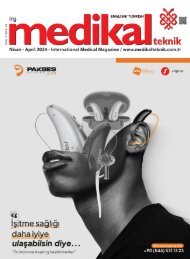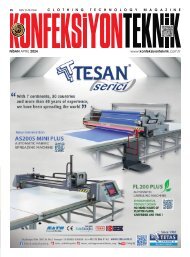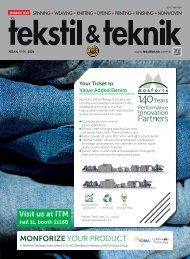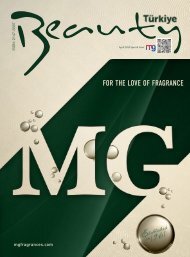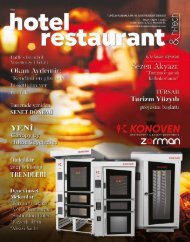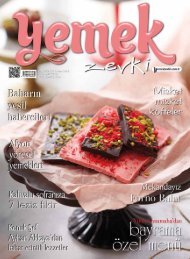Tekstil Teknik October 2020
Tekstil Teknik October 2020
Tekstil Teknik October 2020
- No tags were found...
Create successful ePaper yourself
Turn your PDF publications into a flip-book with our unique Google optimized e-Paper software.
İNCELEME
35
Şekil 1: Fig. 1:
In the late 80’s and beginning 90’s, the maximum
add-on in textile impregnating systems
for bleaching and scouring starts one´s triumph.
A variety of different systems were offered
by the textile manufactures. Typical of those
units was a high add-on off more than 100%
combined with a low volume of the impregnating
unit. All these units were dosing in [ml/
kg] but using different systems for applying the
wanted chemicals on the fabric.
An example of some of those units is visible
in Fig. 1. Please note that the depictured
sketches are not at all copies of existing units,
they are just imitating some working principles.
(Fig. 1)
To understand the working principles and the
impact on the processed fabric we have to
focus on 2 items, the mechanical set-up of
the unit and the dosing method used for the
impregnating unit.
Both points are completely separated and do
not intermingle. The mechanical set-up will
be responsible for all parameters once a unit
is in equilibrium, whereas the dosing should
be evaluated more in view of reliability and a
correct and easy handling.
The mechanical set-up of an impregnating unit
Strictly considered we can reduce an impregnating
system in a simple drawing as shown
in fig 2 where 4 parameters are defining
everything what is happening in an impregnating
system. The properties of the fabric (at
a defined speed, temperature and recipe)
together with the water squeezer (Q1) and
the construction of the impregnating part will
define the exchange. The chemical squeezer
(Q2) will define the amount of liquid on the
fabric. (Fig 2)
Measuring the parameter involved (chapter 3)
and applying them in the formulas given in this
paper will give a detailed view of what is physically
happening in an impregnating system.
Most of the abbreviations used in here are the
following:
m in [kg/min] amount of fabric
passing per minute (speed*weight)
t in [min] time
Şekil 2: Fig. 2:
Kumaş Üzerindeki Flote Miktarı
∆Q in [l/kg] Uygulama Farkı (Q2-Q1)
f
Değişim faktörü, 0,0 ile 1,0 arasında
sayısal bir değer olarak emprenye sırasında
emprenye flotesi tarafından değiştirilen su
miktarı
V in [l] Emprenye ünitesinin hacmi, karıştırma
kabı ve borular dahil toplam flote miktarı.
Epu in [l/kg] Efektif Pick-Up (Epu =Q1*f+∆Q ->
∆Q=Q2-Q1)
Ct in [ml/l] Bir t zamanında emprenye ünitesindeki
konsantrasyon
C∞ in [ml/l] Kimyasal Dengede Emprenye
Ünitesindeki Konsantrasyon (Zaman t=∞)
C0 in [ml/l] Yeni bir üretime başlanması
veya kumaş değişimi gibi t=0 başlangıç anında
Emprenyedeki Konsantrasyon
CF in [ml/l] Besleme Flotesinin Konsantrasyonu.
(CF, emprenye ünitesine giden su ve
kimyasalların toplamının konsantrasyonudur.
Besleme Flotesinin miktarıyla karıştırmamalı
çünkü Besleme Flotesi Miktarı kumaş üzerine
verilen ilave flote (add-on) ile aynı anlamdadır.
Sıkma değerleri, sırasıyla flotenin kumaş üzerine
uygulama miktarlarını [l/kg] birimiyle ifade
ederler. Sıkma değeri için kullanılan ortak terim
%’dir, ancak bu makalede kullanılan formüllerde
olası yanlış anlamaların önüne geçmek
için [l/kg] birimini de kullanmamız gerekecektir.
TEKSTİL & TEKNİK | EKİM | OCTOBER | 2020



